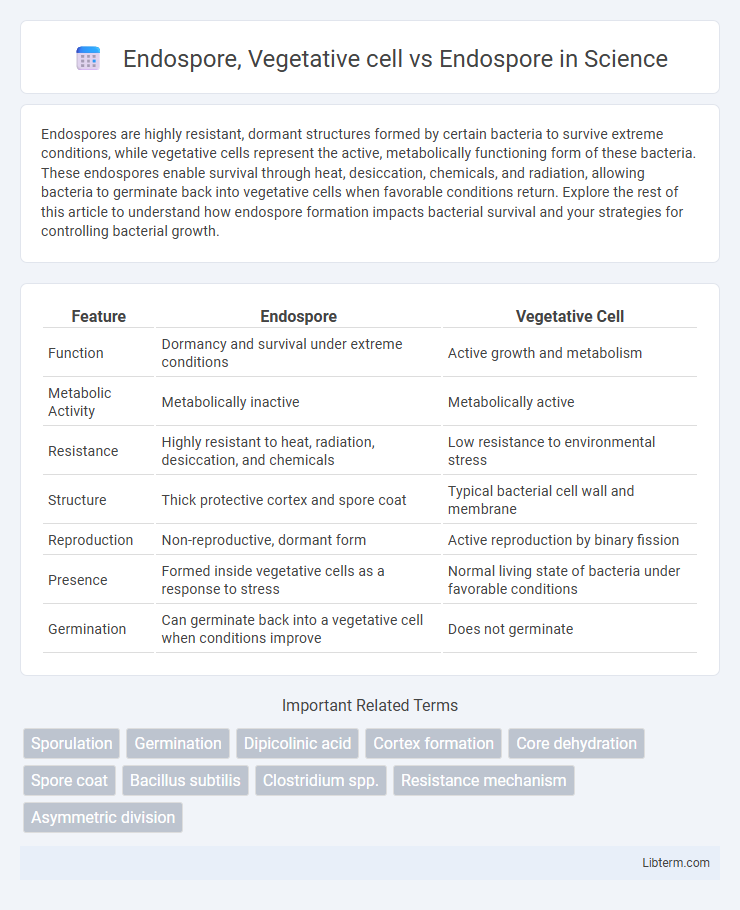Endospores are highly resistant, dormant structures formed by certain bacteria to survive extreme conditions, while vegetative cells represent the active, metabolically functioning form of these bacteria. These endospores enable survival through heat, desiccation, chemicals, and radiation, allowing bacteria to germinate back into vegetative cells when favorable conditions return. Explore the rest of this article to understand how endospore formation impacts bacterial survival and your strategies for controlling bacterial growth.
Table of Comparison
| Feature | Endospore | Vegetative Cell |
|---|---|---|
| Function | Dormancy and survival under extreme conditions | Active growth and metabolism |
| Metabolic Activity | Metabolically inactive | Metabolically active |
| Resistance | Highly resistant to heat, radiation, desiccation, and chemicals | Low resistance to environmental stress |
| Structure | Thick protective cortex and spore coat | Typical bacterial cell wall and membrane |
| Reproduction | Non-reproductive, dormant form | Active reproduction by binary fission |
| Presence | Formed inside vegetative cells as a response to stress | Normal living state of bacteria under favorable conditions |
| Germination | Can germinate back into a vegetative cell when conditions improve | Does not germinate |
Introduction to Bacterial Endospores
Bacterial endospores are highly resistant, dormant structures formed within certain vegetative cells, enabling survival under extreme environmental conditions such as heat, desiccation, and chemical exposure. Vegetative cells represent the metabolically active, growing form of bacteria, whereas endospores are metabolically inactive and designed for long-term preservation of genetic material. The process of sporulation transforms a vegetative cell into an endospore, which can subsequently germinate back into a vegetative cell when favorable conditions return.
Structure and Composition of Endospores
Endospores possess a highly resistant structure, featuring multiple protective layers including the exosporium, spore coat, cortex, and core, which contain dipicolinic acid and calcium that stabilize DNA and proteins. In contrast, vegetative cells lack these complex layers and specialized compounds, making them more vulnerable to environmental stress. The dense, dehydrated core of endospores ensures metabolic dormancy, while vegetative cells maintain active metabolism and typical cellular components like ribosomes and membranes.
Formation Process: Sporulation
Sporulation is a complex, multistage process during which a vegetative cell transforms into a highly resistant endospore to survive extreme environmental conditions. This process involves DNA replication, asymmetric cell division, and the formation of a protective cortex and spore coat around the developing endospore. The resulting endospore exhibits metabolic dormancy and enhanced resistance to heat, radiation, and desiccation compared to the active, metabolically active vegetative cell.
Characteristics of Vegetative Cells
Vegetative cells are metabolically active, growing, dividing, and performing normal cellular functions, characterized by a less resistant cell wall compared to endospores. These cells contain a fully hydrated cytoplasm, enabling enzyme activity and energy production essential for survival under favorable conditions. Unlike endospores, vegetative cells lack the thick protective layers and dehydration that confer resistance to heat, radiation, and chemicals.
Morphological Differences: Vegetative Cells vs. Endospores
Vegetative cells exhibit a metabolically active, irregular, and flexible morphology with a relatively thin cell wall, while endospores display a highly resistant, dormant state characterized by a thick, multilayered spore coat and a dense core. The endospore's cortex, composed of peptidoglycan, is significantly thicker compared to the vegetative cell wall, providing enhanced protection against environmental stresses. Unlike the vegetative cell's cytoplasm, the endospore core contains calcium dipicolinate, aiding in dehydration and increased thermal resistance.
Survival Mechanisms of Endospores
Endospores are highly resistant structures formed by certain bacteria to survive extreme environmental conditions such as heat, desiccation, and chemical exposure. Unlike vegetative cells, which are metabolically active and vulnerable to stress, endospores enter a dormant state with a tough protective coat and dehydrated core that preserves vital cellular components. This survival mechanism allows bacteria to withstand unfavorable environments for extended periods, ensuring long-term persistence and rapid revival when conditions improve.
Physiological Differences and Functions
Endospores exhibit extreme resistance to heat, desiccation, and chemicals due to their thick protective layers and low metabolic activity, unlike vegetative cells that actively metabolize and replicate under favorable conditions. Vegetative cells function in growth and reproduction, while endospores serve as a dormant survival form enabling bacteria such as Bacillus and Clostridium species to withstand harsh environments. The physiological difference lies in the metabolic dormancy of endospores, which contain dipicolinic acid and high calcium content, providing stability absent in metabolically active vegetative cells.
Environmental Resistance: Endospores vs. Vegetative Cells
Endospores exhibit exceptional environmental resistance, surviving extreme heat, desiccation, radiation, and chemical disinfectants that typically destroy vegetative cells. Unlike metabolically active vegetative cells, endospores enter a dormant state with a thick protective cortex and spore coat, enhancing resilience against harsh physical and chemical conditions. This adaptive resistance mechanism allows endospores to persist in unfavorable environments for extended periods until conditions become suitable for germination.
Significance in Medical and Industrial Contexts
Endospores, highly resistant dormant structures formed by bacteria such as Bacillus and Clostridium species, play a critical role in medical settings by enabling persistence through harsh conditions, complicating infection control and sterilization processes. Vegetative cells represent the active, metabolizing bacterial form responsible for growth and reproduction, making them the primary target in antimicrobial treatments. In industrial contexts, endospores' resilience affects food safety and sterilization protocols, necessitating specialized techniques to prevent contamination and spoilage.
Applications and Detection Methods
Endospores exhibit remarkable resistance to extreme environmental conditions, making them critical in sterilization processes and food safety applications. Vegetative cells, being metabolically active, are targeted using standard microbiological detection methods like culture techniques, whereas endospore detection relies on specialized methods such as spore staining (Schaeffer-Fulton method) and molecular assays like PCR for identifying spore-specific genes. The durability and dormancy of endospores necessitate advanced detection protocols to prevent contamination in clinical diagnostics and pharmaceutical manufacturing.
Endospore, Vegetative cell Infographic

 libterm.com
libterm.com